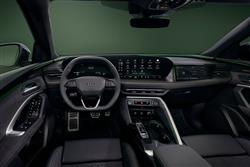Audi Q5 Sportback - ABC Leasing
SPORT FOR ALL?(some text hidden)
By Jonathan Crouch
Ten Second Review word count: 33
In Europe, Audi's Q5 mid-sized SUV sells mostly in this sleeker Sportback form. It's not previously been quite like that in the UK, but this second generation Q5 Sportback model might change things.
Background word count: 147
Question: is it really necessary for a premium-badged mid-sized SUV to also be available with a second, sleeker coupe body shape? Some brands, like CUPRA, Genesis, Porsche and BMW don't think so. Others, like Mercedes and Audi, remain convinced that a second coupe body shape is needed - and it's Audi's take on that, the Q5 Sportback, that we look at here. This body style first arrived at the time of the previous generation Q5's mid-term facelift in 2020 and, understandably given what was happening in the world back then, didn't attract much attention. Unfortunately, it's rather frumpy looks didn't attract much pavement passer-by attention either, which rather put the car at a disadvantage compared to its arch-rival, the Mercedes GLC Coupe. So in late 2024, as part of a new generation Q5 launch, Audi tried again, creating the sleeker MK2 Q5 Sportback we look at here.
Driving Experience word count: 466
Obviously, a Q5 Sportback doesn't drive any differently from a Q5 SUV. Customers of premium upper mid-sized SUVs don't typically tend to prioritise an involving driving experience - and if they do, they don't tend to choose this one. Yet if for you, driving enjoyment lies with a lowering, rather than a raising of the heartbeat, you might really appreciate what Audi has tried to do with all versions of this Q5. The engines on offer here are pretty familiar and as before, all versions come with quattro 4WD and 7-speed dual clutch S tronic auto transmission. What's new is that it all sits on completely new underpinnings, the 'PPC' 'Premium Platform Combustion' chassis we've already seen in the new A5. Development of new combustion-based fundamentals here tells you everything about how long Audi thinks the EV revolution will take to get into full swing. As for those engines, well perhaps the most surprising news is that one of the mainstream ones is still a diesel. The EA288 evo generation 2.0 TDI unit develops the same 204PS output as the alternative 2.0 TFSI petrol powerplant, but quite a lot more torque (400Nm, as opposed to 340Nm) - which will be of interest to towers. The continuing top SQ5 sporty model now isn't a diesel, the old 3.0 TDI V6 unit now swapped for 3.0 TFSI petrol V6 that produces 367PS and a gutsy 550Nm of torque. All the mainstream engines are aided by the brand's 'MHEV plus' mild hybrid system, which is different from the old MHEV set-up in that in addition to the usual system-integrated starter-generator, there's also a second centrally-mounted powertrain generator. The result is dramatically increased levels of regenerative braking - and consequently, a bit more of a positive impact on efficiency. You might also want to consider the e-hybrid PHEV. This uses a 2.0-litre TFSI turbo petrol unit, the associated seven-speed s tronic dual clutch auto gearbox and a quattro 4WD system. New (compared to this model's TFSI e predecessor) is the 142PS electric motor the e-hybrid system links to it, energised by a 25.9kWh (20.7kWh net) battery that's 45% bigger than that used by that outgoing TFSI e model. EV drive range is rated at 62 miles and total output at 299PS with 450Nm of torque, allowing for 0-62mph in 6.2s en route to 155mph. With all powertrains, Audi says that drive dynamics have been improved with this third generation model courtesy of a more noticeable spread between drive modes and an 'optimised' steering and suspension set-up. The steering features the brand's 'Progressive' system, whilst the standard passive suspension arrangement now features Frequency Selective Damping, which adapts automatically to different surfaces. Adaptive damping comes only if you stretch to the air suspension that features at the very top of the range.
Pictures (High res disabled)

.jpg)
.jpg)
.jpg)
.jpg)
.jpg)
.jpg)
.jpg)
.jpg)

Scoring
Category: Compact Car
| Performance | |
| Handling | |
| Comfort | |
| Space | |
| Styling | |
| Build | |
| Value | |
| Equipment | |
| Economy | 70% |
| Depreciation | 70% |
| Insurance | 70% |
| Total | 71% |